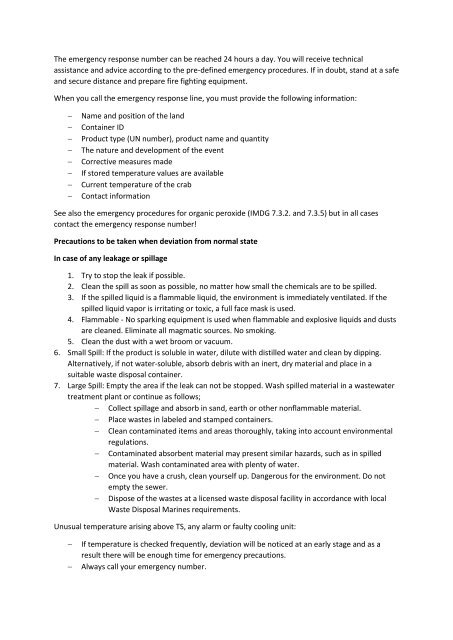Safety aspects for Transportation of Dangerous Goods
You also want an ePaper? Increase the reach of your titles
YUMPU automatically turns print PDFs into web optimized ePapers that Google loves.
The emergency response number can be reached 24 hours a day. You will receive technical<br />
assistance and advice according to the pre-defined emergency procedures. If in doubt, stand at a safe<br />
and secure distance and prepare fire fighting equipment.<br />
When you call the emergency response line, you must provide the following in<strong>for</strong>mation:<br />
<br />
<br />
<br />
<br />
<br />
<br />
<br />
<br />
Name and position <strong>of</strong> the land<br />
Container ID<br />
Product type (UN number), product name and quantity<br />
The nature and development <strong>of</strong> the event<br />
Corrective measures made<br />
If stored temperature values are available<br />
Current temperature <strong>of</strong> the crab<br />
Contact in<strong>for</strong>mation<br />
See also the emergency procedures <strong>for</strong> organic peroxide (IMDG 7.3.2. and 7.3.5) but in all cases<br />
contact the emergency response number!<br />
Precautions to be taken when deviation from normal state<br />
In case <strong>of</strong> any leakage or spillage<br />
1. Try to stop the leak if possible.<br />
2. Clean the spill as soon as possible, no matter how small the chemicals are to be spilled.<br />
3. If the spilled liquid is a flammable liquid, the environment is immediately ventilated. If the<br />
spilled liquid vapor is irritating or toxic, a full face mask is used.<br />
4. Flammable - No sparking equipment is used when flammable and explosive liquids and dusts<br />
are cleaned. Eliminate all magmatic sources. No smoking.<br />
5. Clean the dust with a wet broom or vacuum.<br />
6. Small Spill: If the product is soluble in water, dilute with distilled water and clean by dipping.<br />
Alternatively, if not water-soluble, absorb debris with an inert, dry material and place in a<br />
suitable waste disposal container.<br />
7. Large Spill: Empty the area if the leak can not be stopped. Wash spilled material in a wastewater<br />
treatment plant or continue as follows;<br />
Collect spillage and absorb in sand, earth or other nonflammable material.<br />
Place wastes in labeled and stamped containers.<br />
Clean contaminated items and areas thoroughly, taking into account environmental<br />
regulations.<br />
Contaminated absorbent material may present similar hazards, such as in spilled<br />
material. Wash contaminated area with plenty <strong>of</strong> water.<br />
Once you have a crush, clean yourself up. <strong>Dangerous</strong> <strong>for</strong> the environment. Do not<br />
empty the sewer.<br />
Dispose <strong>of</strong> the wastes at a licensed waste disposal facility in accordance with local<br />
Waste Disposal Marines requirements.<br />
Unusual temperature arising above TS, any alarm or faulty cooling unit:<br />
<br />
<br />
If temperature is checked frequently, deviation will be noticed at an early stage and as a<br />
result there will be enough time <strong>for</strong> emergency precautions.<br />
Always call your emergency number.


